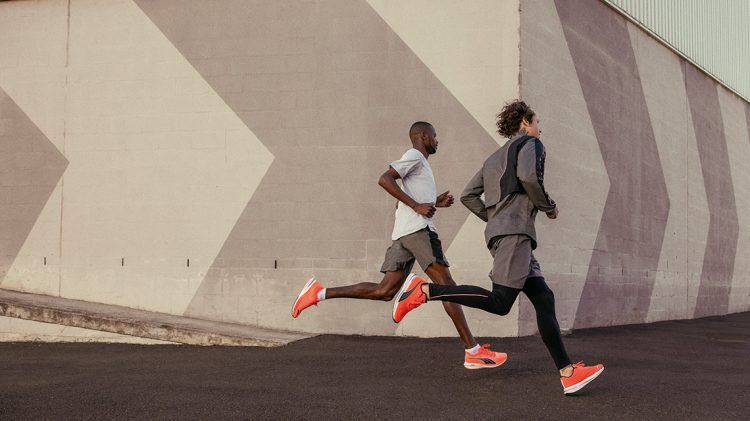 Running & Training
Running & Training
Winter
Running
Hacks
How to make cold-weather running less awful
March 3, 2021How to make cold-weather running less awful
March 3, 2021Winter running is not for the faint of heart. Icy wind in your face, slippery conditions and the enveloping darkness of the winter season… all of the above can make staying cosy and skipping that jog so tempting. But winter running, and cold-weather exercise in general, can be incredibly beneficial for the body and mind. We’ve rounded up some hacks to boost your motivation and make those frosty winter runs more bearable.
Why should you embrace cold-weather cardio?
Running is the O.G. cardiovascular activity. Adults are recommended to get about 150 minutes of moderately intense aerobic activity per week and especially with many of us spending so much more time static and indoors lately, squeezing in a few frigid jogs per week is a gift to your heart and lungs. In freezing weather your heart has to work extra hard to keep you warm and fuel the body with oxygen, meaning winter running strengthens your cardiovascular system while burning more calories and giving a healthy kick to your metabolism.
One of our biggest challenges to staying active in the winter is not physical, but mental. Overcoming the inner voice that whispers how we should stay on the couch rather than getting some movement builds our mental strength, determination and perseverance. Nothing will make you feel more invincible than braving the elements (and the rush of endorphins isn’t bad either).
Especially in these challenging times, getting enough fresh air, sunshine and movement is vital to staying mentally healthy and combating seasonal depression and other mental conditions that stem from a sedentary lifestyle indoors.
Top Tips
- Listen to your heart, literally. Rather than forcing yourself to match your usual running pace, try to tune in to your heart rate and perceived effort, aiming to stay in a consistent working zone.
- Keep an eye on the forecast and prepare accordingly. Heavy snow or freezing rain could impact the safety of your running trail and will affect how you dress, so it is best to have a look at the predictions beforehand.
- In this case, fashion matters. If it’s raining then a hat with a bill and waterproof jacket are must-haves. If it is more frigid and icy then layer up. Quality gear will go a long way to keeping you happy and running steadily.
- A good rule of thumb is to dress for a temperature about 10 to 20 degrees celsius warmer than it is outside to account for the rise in body temperature and avoid overheating. And don’t forget the windchill factor – make your calculations based on the ‘feels like’ temperature rather than the actual.
- Try to plan your route with the wind in your favour. Start by heading out in the wind, so it is on your way back home when you’re warmed up and sweaty.
- Whenever possible, try to find reflective running gear to stay safe even with limited daylight.
- The first 10 minutes are the hardest. If you can push yourself to get dressed, out the door and moving, you’ll soon be thanking yourself and glad you did this.
- Invest in studs or tracks for icy running.
- Change out of your cold and sweaty clothes as quickly as possible post run. Then take the time to carefully stretch your body, which may be more tense than usual due to the cold.
- Staying hydrated is important no matter if it’s summer or winter. Finish your workout with a hot drink or steaming bowl of soup to replenish yourself.
Clothing Checklist
It may take some practise to figure out what layers work for you. Try to find that sweet spot between not being too chilly when starting out, but also accommodating the increase of body temperature. Avoid overly puffy or bulky layers and focus on your extremities which may need extra warmth compared to the core that heats up quickly. A basic checklist:
- Head covering– a lightweight hat, beanie or headband.
- Running gloves or mittens are must-haves.
- Face covering – depending on the conditions a mask or neck gaiter can be super helpful.
- Base layer – something longsleeve and lightweight from a fabric such as wool or poly blend that will keep you warm but won’t stay wet on your skin.
- Pullover, hoodie or sweater – overtop of your base layer for extra heat.
- Running jacket – depends on your needs, but you can’t go wrong with wind-resistant and waterproof.
- Running tights or pants – especially fleece-lined. In really cold weather try layering your tights under your pants.
- Socks – avoid cotton and go for a material that will wick away sweat and keep your feet dry and warm.
- Running shoes – large enough to accommodate thicker socks, with good traction to avoid slippage.
Precautions
The combo of cold, dry air and endurance activities can put extra stress on your respiratory system, so be aware of this especially if you have pre-existing issues with your airways. Likewise cold-weather exercise can put strain on your cardiovascular system which may be dangerous to those with heart disease or other health conditions.
Bottom Line


